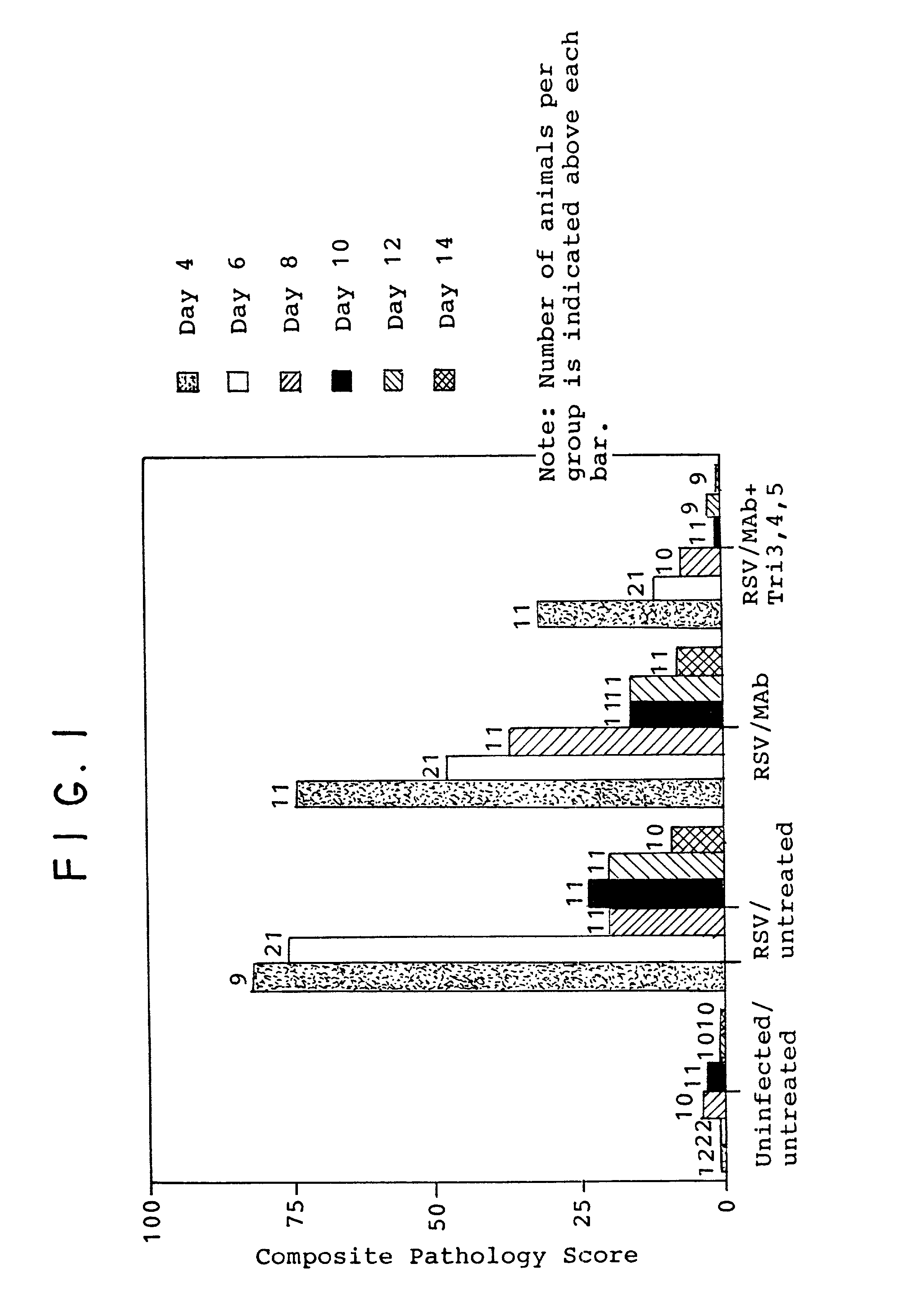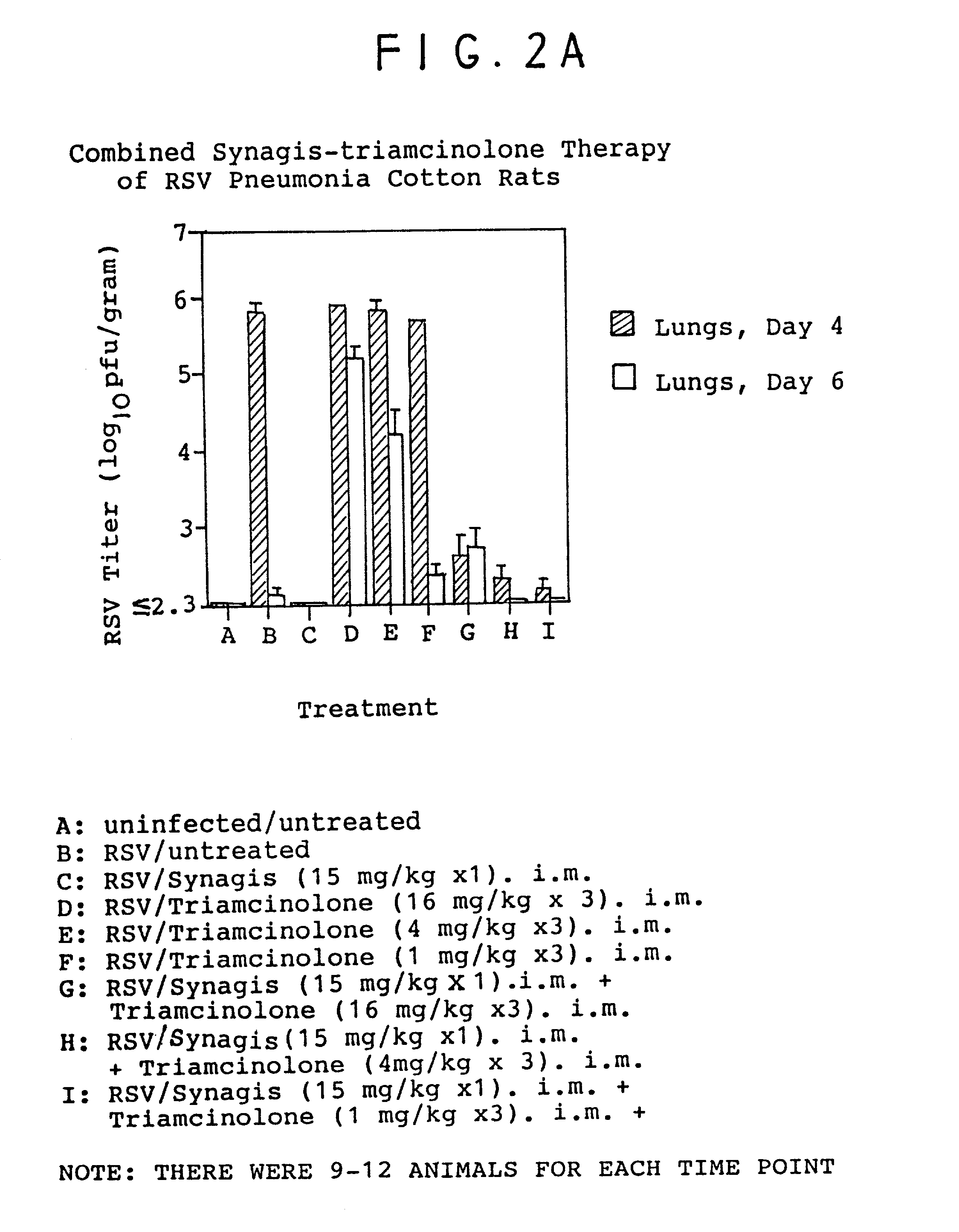Combination therapy of respiratory diseases using antibodies and anti-inflammatory agents
- Summary
- Abstract
- Description
- Claims
- Application Information
AI Technical Summary
Benefits of technology
Problems solved by technology
Method used
Image
Examples
example 2
[0082]The following procedure was performed using inbred cotton rats (Sigmodon hispidus). On day 0, 150 young adult cotton rats were divided into 6 groups of 25 animals each. Identification of each group in terms of treatment was as follows:
[0083]
GroupTreatmentAuninfected / untreatedBRSV / untreatedCRSV / antibody(15mg / kg)DRSV / antibody / triamcinoloneERSV / antibody / triamcinoloneFRSV / antibody / triamcinolone
[0084]In each case (Groups B–F), approximately 106.5 plaque forming units (pfu) of respiratory syncytial virus (RSV / Long) was administered intranasally in a volume of 100 μl.
[0085]On day 3, treatment began as described above for each of the indicated groups (here, groups C–F). All animals were treated according to the indicated regimen with the animals in groups C–F receiving antibody and the animals in groups D–F also receiving steroid (triamcinolone). All antibody and steroid administration was intramuscular (i.e., systemic) and both antibody and steroid were administered together. Antibod...
example 3
[0096]The following procedure was performed using inbred cotton rats (Sigmodon hispidus). On day 0, young adult cotton rats were divided into 8 groups of 4 animals each (total: 32 animals). Identification of each group in terms of treatment was as follows:
[0097]
GroupTreatmentAuninfected / untreatedBRSV / untreatedCRSV / antibody(15mg / kg) i.m.DRSV / triamcinolone(16mg / kg) i.m.plus antibody(daily as one dose)ERSV / solumedrol(4mg / kg) i.p. / plus antibody(Medrol given as1mg / kg Q 6 hours)FRSV / solumedrol(8mg / kg) i.p. / plus antibody(Medrol given as1mg / kg Q 6 hours)GRSV / dexamethasone(0.6mg / kg) i.p. / plus antibody(Daily as one dose)HRSV / dexamethasone(1.2mg / kg) i.p. / plus antibody(Daily as one dose)
[0098]In each case (Groups B–H), approximately 106.5 plaque forming units (pfu) of respiratory syncytial virus (RSV / Long) was administered intranasally in a volume of 100 μl.
[0099]On day 3, treatment began as described above for each of the groups. The animals were each weighed and treated according to the indic...
example 4
[0104]The following procedure was performed using inbred cotton rats (Sigmodon hispidus). On day 0, young adult cotton rats were divided into 3 groups of 6 animals each (total: 32 animals). Identification of each group in terms of treatment was as follows:
[0105]
GroupTreatmentAuninfected / untreatedBRSV / untreatedCRSV / triamcinolone(16mg / kg) i.m.plus antibody(daily as one dose)
[0106]In each case (Groups B and C), approximately 106.5 plaque forming units (pfu) of respiratory syncytial virus (RSV / Long) was administered intranasally in a volume of 100 μl.
[0107]On day 3, treatment began as described above for each of the groups. The animals were each weighed and treated according to the indicated regimen. Antibody was palivizumab wherein 15 mg / kg was the dose used in each case. All dosages are given as mg per kg of body weight. Treatment with antibody and steroid was intramuscular (i.m.).
[0108]On day 4, three animals from each group were sacrificed and their lungs trisected as follows: two l...
PUM
| Property | Measurement | Unit |
|---|---|---|
| Dimensionless property | aaaaa | aaaaa |
| Dimensionless property | aaaaa | aaaaa |
| Dimensionless property | aaaaa | aaaaa |
Abstract
Description
Claims
Application Information
 Login to View More
Login to View More - R&D
- Intellectual Property
- Life Sciences
- Materials
- Tech Scout
- Unparalleled Data Quality
- Higher Quality Content
- 60% Fewer Hallucinations
Browse by: Latest US Patents, China's latest patents, Technical Efficacy Thesaurus, Application Domain, Technology Topic, Popular Technical Reports.
© 2025 PatSnap. All rights reserved.Legal|Privacy policy|Modern Slavery Act Transparency Statement|Sitemap|About US| Contact US: help@patsnap.com



